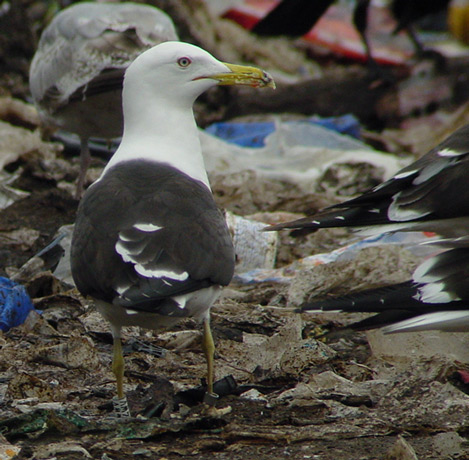
(2 images) Larus fuscus fuscus 3cy C4WV, July 09 & 12 2003, Tampere, Finland (61.33N 24.59E).
C4WV was ringed in Ääneko, Finland;
ringed as pullus on July 06 2001. Hand when ringed 250 mm.
Recorded
at Tampere:
2003-06-22,
2003-06-29,
2003-07-02, 2003-07-09, 2003-07-11, 2003-07-12, 2003-07-20.
Larus fuscus fuscus in 2cy often returns
with completely replaced primaries and secondaries. In 3cy, fuscus more
often shows a clear division between fresh inner primaries and older outer
primaries, the inner primaries often showing neat white tips and the outer
primaries often second generation-like with rounded tips and paler bleached
brown. The arrested moult in the primaries is often reflected in the secondaries
and (to a less extend) in the tail-feathers as well. The older tail-feathers
(often R5 is older) still show a broad dark sub-terminal band.
3cy fuscus often have some black markings on the bill, which is otherwise
much adult-like, with a clear red gonydeal spot. The colour of the naked parts
are adult-like as well.
The scapulars in 3cy are often completely adult-like, lacking internal patterns;
plain blackish grey with a mahogany hue on the older feathers. Most wing-coverts
and tertials are adult-like blackish grey as well, but often 3cy birds show some
very bleached pale brown wing-coverts, normally in the greater covert bar and in
the upper rows of the lesser coverts. These bleached wing-coverts accentuate the
jumpy sequence in the last wing-covert moult cycles, as there is often no clear
pattern in location of these bleached feathers. Head and body feathers normally
are snow-white by July.
C4WV was ringed as pullus in 2001, now in 3cy. This 3cy fuscus
has arrested primary moult prior to northbound migration: there is a
division in the visible outer primaries between P8 and P9. The two outer primaries
(P9-P10) are bleached brown, but there is a mirror on P10. The inner primaries,
P1-P8, are much darker
with small white tips, typical 3rd generation.
Note the black markings on the bill and the strong brown mahogany hue on the
wing-coverts.
